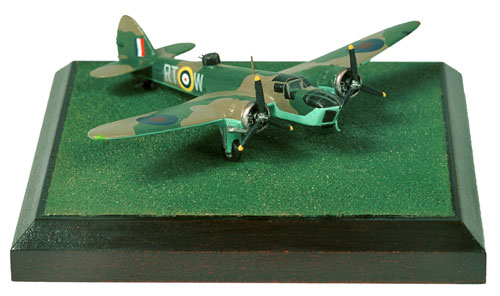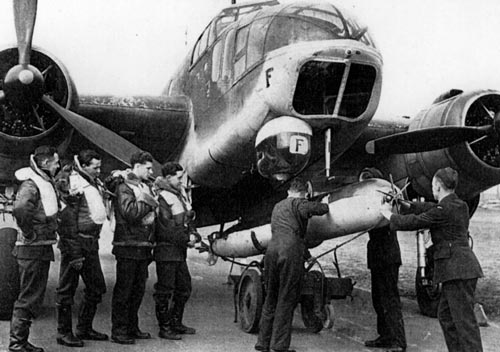Bristol Blenheim Mk IV
Bristol Blenheim Mk IV RT-W R3891 114 Squadron,
Coastal Command, June 1941.

Scale 1:144 Wingspan 4.72″ (123 mm)
Base size 4.84″ (123 mm) square (No. 3)
Weight not including base 4 ozs (113 grams)
Total number of models produced 495
This is the aircraft which sighted the German Battleship Lutzow allowing it to be subsequently attacked by Bristol Beaufort torpedo bombers. What follows is the account of the Bristol Blenheim Mk IVs pilot Sergeant Pilot T. N. Staples.
About the middle of June 1941, 114 Squadron moved from its base at Thornaby (near Middlesborough) to Leuchars in Scotland, a few miles south of Dundee on the opposite side of the Firth of Tay. The Squadron was still temporarily under the operational control of Coastal Command for convoy escort duties along the East Coast, and for strike and reconnaissance operations along the Norwegian coast. I was still a Sergeant Pilot with an N.C.O. crew and we flew into Leuchars on 12th June 1941. I think it must have been about mid-day or early afternoon.
No battle order had been published that affected us that day and we were not on stand-by, but some time after we arrived I was called to the Operations Room with my crew. We were told that we were required for operations that evening at short notice as intelligence had been received that a German capital ship and its escort was on its way into the North Sea from the Baltic, presumably to break out into the Atlantic to attack Allied shipping and particularly the Atlantic convoys. We were to be one of the two reconnaissance aircraft being sent out by the Squadron ahead of a force of torpedo bombers, to locate the ship for a torpedo attack to be launched against it. The essence of the pre-flight briefing was that the ship was thought to be a pocket battleship and that it was expected to be sailing out of the Skagerrak and up the Norwegian Coast that evening. One thing in particular was impressed upon us: it was that we were to locate the ship if possible without ourselves being detected, so as to give the torpedo, bombers the advantage of surprise. For this reason we were not required to shadow the ship which, in any event, would hardly have been a practical proposition at the same time as transmitting the position report as you will see. Although still a Sergeant Pilot, I was one of the more experienced pilots available on this particular evening as I had been with the Squadron for almost ten months and had an especially well qualified navigator. He was eight or nine years older than I was, and had been in the Merchant Navy before joining the R.A.F. At the beginning of the war I understood that he had qualified for a First Mate’s ticket, which gave him a sound navigational background in addition to his R.A.F. training. For this reason, I was detailed to lead the section of two aircraft to a point on the west coast of Norway where I would turn south and search as far as the most southerly point of the coastline: the other aircraft would turn north to search.
I think we must have taken off about nine-thirty in the evening. I cannot recall what the weather was at base, but I can remember flying at about 1,500 or 2,000 ft. to enable my navigator to take the necessary drift measurements for his dead reckoning navigation as we had no other navigational aid or facility. When we were about 50n.m. from the Norwegian coast I descended to a lower level to avoid detection, and then at the prearranged point off the coast we separated. It was about eleven thirty; there was low cloud with the base about 1,OOOft., the sea was choppy and the visibility was not good in the midnight twilight of northern latitudes at that time of year. It seemed that the Germans had chosen favorable conditions for the movement of their ship.
My navigator, with his sea-going experience, was convinced that the battleship and its escort would not be found in the coastal shipping lane just a few miles offshore but was more likely to be sailing in open waters further out to sea. I respected his judgment, and we began our search flying parallel to the coast about 25n.m. out to sea. We flew this south-easterly course until we had almost reached the end of our patrol line, and I was beginning to wonder if we had done right in being so far out to sea when I saw ahead of me a float plane heading towards the land. I should have connected it with the presence of the enemy ships but I did not and my initial reaction was to attack it. Bearing in mind the purpose of our reconnaissance, this would have been a mistake; but given a few moments to think about it, I am sure I would have reached that conclusion and would have turned to fly back up the coast to continue the search closer inshore. By a stroke of good fortune, combined with my navigator’s good judgement, the situation resolved itself before I had time to think any more about the float plane. Ahead, and slightly to starboard, the pocket battleship and its escort of five destroyers – two either side and one ahead – suddenly came into view, with fighters overhead. The ships were not much more than a mile away.As I turned away to port I entered the low cloud for concealment and alerted my wireless operator/air gunner to the job ahead of transmitting our sighting report. To do this he had to lower himself from his turret to operate his set in the fuselage to the rear of his position and wind out a trailing aerial!
During this time there was no rear look-out and no defence against fighter attack. It was impossible to tell whether we had been detected I saw the fighter escort and they may have seen me. The account of the action in “The Ship Busters” is highly dramatised and says that we were under fighter attack (p.22). This was not so and we had not reported it to be. The fact that we did not shadow the ships was in keeping with our operational briefing, which may not have been known to Coastal Command Headquarters. The report prepared by my navigator was that we had sighted the ships 30n.m. south of Lister steering west-north-west at a speed of 22 knots. This was at midnight on 12th/13th June. We learned later that the pocket battleship was the Lutzow.
We naturally wondered about the accuracy of our sighting report as our navigation had been entirely by dead reckoning. The Lutzow was torpedoed at 2.18 a.m. on 13th June off Egersund, having sailed roughly 5On.m. since we saw it. That is almost exactly where we would have expected it to be on the basis of our sighting 25n.m. out to sea.

Photograph courtesey of Roy Conyers Nesbit. On 13 June 1941, several Beaufort Is of 42 Squadron were despatched from Leuchars in Fife to hunt the German heavy cruiser Lutzow (sometimes called a pocket battleship) which was known from Enigma decrypts to be off the coast of south-west Norway. One of these, serial L9939 flown by Flt Sgt Ray H. Loveitt, came across the warship escorted by destroyers and made a surprise attack. The torpedo scored a hit and put the warship out of action for several months. Loveitt was awarded a DFM. He is shown here, fourth from left, while another torpedo is being loaded on his Beaufort.

